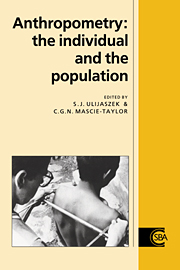Book contents
- Frontmatter
- Contents
- List of contributors
- Preface
- Acknowledgements
- 1 The place of anthropometry in human biology
- 2 Asymmetry and growth
- 3 Intra- and inter-observer error in anthropometric measurement
- 4 Statistical issues in anthropometry
- 5 Statistical constructs of human growth: new growth charts for old
- 6 Growth monitoring and growth cyclicities in developed countries
- 7 Growth monitoring, screening and surveillance in developing countries
- 8 Variability in adult body size: uses in defining the limits of human survival
- 9 Anthropometry and body composition
- 10 Anthropometry and physical performance
- 11 Anthropometry, strength and motor fitness
- 12 Anthropometry in the US armed forces
- Index
6 - Growth monitoring and growth cyclicities in developed countries
Published online by Cambridge University Press: 19 November 2009
- Frontmatter
- Contents
- List of contributors
- Preface
- Acknowledgements
- 1 The place of anthropometry in human biology
- 2 Asymmetry and growth
- 3 Intra- and inter-observer error in anthropometric measurement
- 4 Statistical issues in anthropometry
- 5 Statistical constructs of human growth: new growth charts for old
- 6 Growth monitoring and growth cyclicities in developed countries
- 7 Growth monitoring, screening and surveillance in developing countries
- 8 Variability in adult body size: uses in defining the limits of human survival
- 9 Anthropometry and body composition
- 10 Anthropometry and physical performance
- 11 Anthropometry, strength and motor fitness
- 12 Anthropometry in the US armed forces
- Index
Summary
Introduction
In Western nations, the causes of growth failure are usually genetic or constitutional rather than environmental, most children attending growth clinics having short stature as the main manifestation of growth failure. The causes of short stature include the following: (i) familial or congenital conditions; (ii) constitutional delay of growth and puberty; (iii) chronic systemic disorders; and (iv) endocrine abnormalities (Tanner, 1989). Regardless of aetiology, the initial aim of growth monitoring is to identify children with growth failure as early as possible for more detailed examination. It is therefore of some concern that a child, once identified as being small on the basis of one measurement of either length (in children below two years of age) or height (in children above two years of age), be designated as having acceptable or unacceptable growth velocity as soon as possible after this first measurement. This chapter examines why a potentially simple procedure is not always as straightforward as it might be.
Normal growth
The pattern of growth in any population can be represented by the centile distribution of stature by age; a number of developed countries have centile charts based on the measurement of their indigenous, healthy population, which is defined to be in some way normal. Countries with their own growth references include Britain (Tanner, Whitehouse & Takaishi, 1966), the United States (National Center for Health Statistics, 1977), the Netherlands (Roede & van Wieringen, 1985) and Belgium (Wachholder & Hauspie, 1986). All of these use the construct of anthropometric percentiles, as developed by Galton (1885).
- Type
- Chapter
- Information
- AnthropometryThe Individual and the Population, pp. 99 - 107Publisher: Cambridge University PressPrint publication year: 1994
- 1
- Cited by



